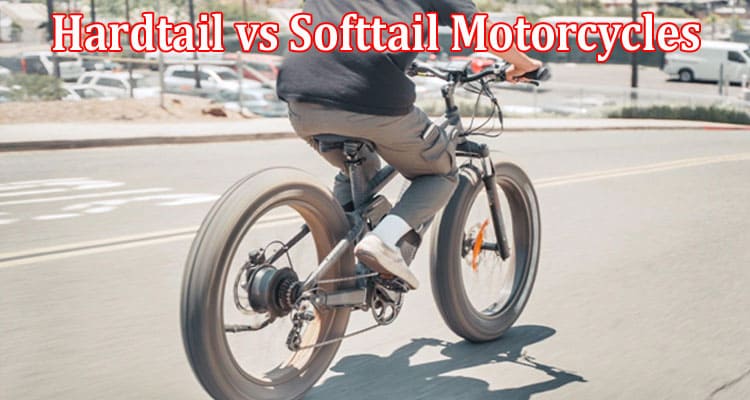Hardtail vs Softtail Motorcycles: What’s the Difference?
Riding a motorcycle can be liberating, especially when you have the right type of bike, that finds the perfect balance between speed and agility. This is why few companies in the motorcycle market can match Harley Davidson for their flawless designs and cutting-edge technologies. Although Ebikes have been changing the narrative in recent times, there still exists a desire for both softtail and hardtail bikes.
The Softail motorbike, created in 1983, is possibly the best illustration of the company’s capacity to advance the sector. When it first appeared, it completely altered how motorcyclists view the road.
The softtail is currently the most preferred electric motorcycle model. Hardtails still have their share of supporters despite being known for delivering a smoother ride that allows you to relax and take in the scenery of the route.
Hardtail motorcycles have inflexible, vintage-style frames without a back suspension. Through the first part of the 20th century, hardtail bikes dominated the market. Hardtails were not designed with suspension, making them unsuitable for long-distance riding. An A-frame rear swing arm serves as the active suspension system on Softail motorcycles.
Both designs have their differences in performance and basic functionality, however, riders have different preferences and some may choose to go for either. Ebike stands out from the aforementioned design types because they perfectly blend the strengths of the both designs to produce a matchless hybrid.
Hardtail vs Softail: Design
Before the experts at Harley Davidson modified the rules, the hardtail design dominated the road for many years. Motorcycles had a single frame with front and rear wheel suspension before the introduction of the Softail. This is a hardtail, as the name suggests.
The Softail has a tiny frame toward the back of the bike that houses the rear wheel suspension. For greater impact resistance, this results in a completely different suspension system. Given that everything is contained within the same frame, the hardtail has a rather straightforward design.
Manufacturing is made simple as a result. The architecture of the Softail makes it intrinsically more sophisticated and necessitates the production of more parts and resources. When comparing the two, you might not be able to tell the two apart. Before you start driving, the additional small frame is barely noticeable.
Hardtail Advantages and Disadvantages
It can be unpleasant to ride a hardtail motorcycle. While a telescopic or comparable suspended front fork is included, there is no rear suspension mechanism built into the stiff frame of the vehicle. Only the front fork, the tires, and one seat with springs are used for the suspension.
The only ride-cushioning feature of two-up seats was padding. The hardtail is reminiscent of early wartime sports cars where the goal of driving would be to experience the road. The same direct sense of the road was offered by hardtails to the rider.
Fewer riders are choosing hardtail motorcycles as more riders prefer Softail models. They now have the fundamental difference of being vintage because of this.
However, many riders continue to like riding hardtail motorcycles. Many people believe that the hardtail truly catches the spirit of the road. Some people argue that the purpose of riding a bike is to experience every curve and break in the road. You could always choose to go in comfort by taking a hummer.
Additionally, hardtails cost less than softails. Fewer components need to be produced and replaced, which can eventually result in financial savings for you. Of course, some passengers may find increased turbulence to be unsettling. After several hours of driving, your legs or bum could start to hurt.
Rough or unpaved roads may also be challenging for you to navigate. If you’re not used to navigating rocky terrain, this could increase your risk of having an accident. Good luck persuading them to ride on the back of a hardtail if they want a smoother ride. Hardtails are much less prevalent than they once were. Replacement components may not be available at all auto shops and retailers. This makes maintenance pretty difficult.
Ebikes appear to be a more durable alternative as they glide effortlessly on both smooth and rocky, uneven terrains. For example Himiway E-bikes have products solely dedicated to off-road courses, boasting of the best attributes of both softtail and hardtail bikes.
Softail advantages and disadvantages
Harley-Davidson’s response to a younger generation of riders that wanted more comfort while riding was the Softail line of motorcycles.
It came with several deviations that focused on the needs of the modern rider with a design more focused on comfort and convenience regardless of whether it is a short or a long ride.
Solving the issue of long-distance riding was a big plus because it had become a real pain in the rear for hardtail motorbike riders. Shock absorbers are positioned horizontally beneath the frame of Softail’s suspension system, hiding them from view.
Due to its rigid frame, which is largely due to the addition of several parts, the Softail resembles a hardtail in appearance. The bike features a traditional hardtail appearance but a softer ride. Numerous softails, including the Rocker, Cross Bones Bobber, and Fatboy models, were created by Harley-Davidson.
The Cross Bones might be the model that most closely mimics vintage hardtails. The Softail lessens turbulence so you may drive in comfort. For a calmer ride, the additional rear suspension helps to absorb more of the cracks and jolts. Although there will still be some bumps, they won’t be nearly as bad as they would be if you were riding a hardtail.
You won’t experience vibration fatigue even after prolonged rides. If the route is clear, your friends and family might also be more likely to accompany you. You’ll be able to concentrate better on the road if there is less turbulence. Instead of stressing concerned about losing grip on your motorcycle when you encounter a pothole, you can unwind.
When deciding which to choose between these bike types, funds may be a problem. In any case, hardtails are less expensive to manufacture and repair than softails. Nevertheless, what matters essentially is your preference
You could also miss a hardtail motorcycle’s bumpy ride. A Softail may leave you yearning for more if you enjoy the sensation of every bump and pothole that may be shifting beneath you. The discussion between Softail and hardtail will probably never end.
Consider this advice as you select the best riding style for your preferences. Regardless of whatever one you decide on; always ride safely by wearing the appropriate motorcycle gear.
Ensuring you have all protective gear on helps in increases the chances of coming out unscathed, in case there is a motorcycle accident.
Differences between Hardtail and Softail Bikes
| S/N | Attributes | Hardtail | Softtail |
| 1. | Riding Comfort | A times bumpy and unpleasant | Smooth rides guaranteed |
| 2. | Agility | Fairly quicker | A bit slower |
| 3. | Handling | Can be odd on rough terrain | Glides through smoothly |
| 4. | Climbing Ability | Pretty fast when compared to the softtail | Slower to a certain extent |
| 5. | Rocky Terrain Climbing Ability | Unpleasant(Loss of traction) | Climbs steadily conveniently moving through rocky paths |
| 6. | General Maintenance | Doesn’t require as much maintenance as softtail | Will require a bit more maintenance to function optimally |
| 7. | Overall Weight | A bit lighter | A bit heavier |
Himiway Softail and Hardtail Bike Types
It is no longer a secret that e-bikes are taking over the market and no other brand produces better products than Himiway. The Himiway collection features mostly softtail design mountain bikes that give smooth rides, gliding through mountains with ease and comfort. Of all these bikes, none closely match the features of a softtail motorcycle like the Himiway Cobra Pro.
- Himiway Cobra Pro: The Himiway Cobra Pro is a power house rugged built for mountain biking and difficult terrains. Its 48V battery, powers it for 60-80 miles with a payload capacity that reaches up 400lbs. It enables all the unique feature that makes a softtail bike unique. It’s ten speed gear system help you get around quickly in style and panache.
Advantages of Ebikes over Hardtail and Softtail Bikes
1. Long Battery life
Hardtail and softtail motorcycles use combustion engines which require fuel. This is not the case with ebikes as they are powered by batteries. These batteries are capable of lasting for long periods and riders don’t have to worry about running out of power.
2. Unique Climbing Ability
With most ebikes you don’t have to worry about whether it’s a softtail or a hardtail design as most products are built to withstand difficult terrains. This puts ebike a class above conventional motorcycles be it softtail or hardtail. With the push of a button riders can power through hills and rocky terrains.
3. Weight
Both softtail and hardtail bikes are quite heavy weighing up to a massive 200kg. Imagine having to push this amount of weight around when on a hiking trip, surely this will be quite unpleasant. Ebikes on the other hand provide a much better alternative as they are lighter weighing an average of 25kg.
4. Maintenance
Generally electric bikes require very little maintenance and brand new ones will remain functional for many years. Softtail and hardtail motorcycles require alot of maintenance and buyers may need to be prepared for extra costs apart from the cost of purchase.
Conclusion
In conclusion, you are in for a treat if you choose any motorcycle because each one will in its own manner give you a distinctive riding experience. However, your own preferences will eventually play a major role in determining which style you choose to utilize.
The softtail bike is your best option if you like leisurely rides and gentle ascents. But it is preferable to get the Hardtail if you want faster, dirtier riding. Whatever you decide, enjoy yourself, ride safely, and create lasting memories.




